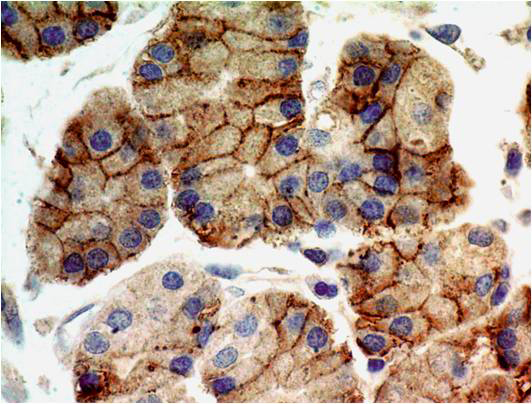
Immunohistochemical analysis of TLR9 in paraffin-embeded sections of human stomach tissue using anti-TLR9, mAb (ABM1C51) (AG-20T-0308) at 5microg/ml.
anti-TLR9, mAb (ABM1C51)
AG-20T-0308
ApplicationsFlow Cytometry, Western Blot, ImmunoHistoChemistry
Product group Antibodies
ReactivityHuman, Mouse
Product AG-20T-0308 is not available
Product not available
There may be an alternative product available, please contact our technical support team.
Overview
- SupplierAdipoGen Life Sciences
- Product Nameanti-TLR9, mAb (ABM1C51)
- Delivery Days Customer10
- Antibody SpecificityRecognizes human and mouse TLR9.
- ApplicationsFlow Cytometry, Western Blot, ImmunoHistoChemistry
- CertificationResearch Use Only
- ClonalityMonoclonal
- Clone IDABM1C51
- Concentration0.5 mg/ml
- HostMouse
- IsotypeIgG1
- Scientific DescriptionMonoclonal Antibody. Recognizes human and mouse TLR9. Isotype: Mouse IgG1kappa. Clone: ABM1C51. Applications: FACS, IHC, WB. Liquid. In PBS containing 0.05% BSA and 0.05% sodium azide. TLR9 (Toll-like Receptor 9) is a member of the TLR (Toll-like receptor) family that plays a fundamental role in pathogen recognition and activation of innate immunity. TLR9 is expressed by numerous cells of the immune system such as B lymphocytes, monocytes, natural killer (NK) cells and plasmacytoid dendritic cells. It is expressed intracellularly, within the endosomal compartments and functions to alert the immune system of viral and bacterial infections by binding to DNA rich in CpG motifs. This nucleotide-sensing TLR is activated by unmethylated cytidine-phosphate-guanosine (CpG) dinucleotides (also called oligodinucleotides, ODNs), and consequently signals via MYD88 and TRAF6, leading to NF-kappaB activation, cytokine secretion and the inflammatory response and eventually activation of a Th1-biased adaptive immune attack. Specific TLR9 agonists have been shown to have substantial antitumor activity, making the TLR9 signaling pathway an interesting target for therapeutic research. - TLR9 (Toll-like Receptor 9) is a member of the TLR (Toll-like receptor) family that plays a fundamental role in pathogen recognition and activation of innate immunity. TLR9 is expressed by numerous cells of the immune system such as B lymphocytes, monocytes, natural killer (NK) cells and plasmacytoid dendritic cells. It is expressed intracellularly, within the endosomal compartments and functions to alert the immune system of viral and bacterial infections by binding to DNA rich in CpG motifs. This nucleotide-sensing TLR is activated by unmethylated cytidine-phosphate-guanosine (CpG) dinucleotides (also called oligodinucleotides, ODNs), and consequently signals via MYD88 and TRAF6, leading to NF-kappaB activation, cytokine secretion and the inflammatory response and eventually activation of a Th1-biased adaptive immune attack. Specific TLR9 agonists have been shown to have substantial antitumor activity, making the TLR9 signaling pathway an interesting target for therapeutic research.
- ReactivityHuman, Mouse
- Storage Instruction2°C to 8°C,-20°C
- UNSPSC12352203
